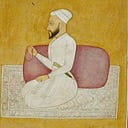In 1947 British India was partitioned into two independent countries, India and Pakistan. The latter being a conglomeration of the Muslim-majority regions of British India, with the former being everything else. At least that was the idea. When examining how the British drew the boundary between these two states, it becomes clear they really botched the job, particularly in Punjab.
Above is a depiction of the British Punjab province, showing the Muslim percentage at the tehsil and selected sub-tehsil level. The yellow line through the middle denotes where the British drew the border which would separate Pakistan and India. A few notes below.
- Just a quick glance conveys how unfavorable this boundary line was for Pakistan. 9 Muslim-majority tehsils and 14 Muslim-majority sub-tehsils in Central-Punjab were awarded to India, despite being contiguous with the rest of Muslim-majority West-Punjab. Not a single non-Muslim tehsil was awarded to Pakistan.
- There are a number of theories as to why the British decided on such a one-sided border arrangement. Some chalk it up to Mountbatten (last Viceroy of India who oversaw partition) and his personal dislike of Jinnah (founder of Pakistan). Others say it was part of a British plot to ensure India’s victory in the inevitable Kashmir-conflict; specifically with regards to the Firozpur (contained large military stores) and Gurdaspur (main access road to Kashmir) districts.
- The most convincing explanation I’ve seen has to do with the sympathy the British felt for the Sikh community. There was a feeling that while the Muslims would have Pakistan, and India would be dominated by Hindus, Sikhs were being left out in the cold. Most holy Sikh sites were at risk of being lost to Pakistan, and as Sikhs were only a majority in 3 tehsils, they couldn’t put forward a serious case for a separate Sikh state. Therefore, the British invoked a clause in the partition agreement known as , “other factors”, where Muslim demographic considerations were overruled by the location of Sikh holy shrines, past service rendered to the British by Sikh soldiers, and the Punjab previously being ruled by a Sikh Empire.
- Ironically, this “other factors” clause only exists because of lobbying by Jinnah and the Muslim League years earlier, when they hoped to secure Hindu-majority areas for Pakistan based on India’s long history of Muslim rule. To be impaled on the sword you sharpened.
- That Muslim majority area towards the right near Delhi is home to the Meos, an interesting community, and the only significant population of Muslims to survive in East-Punjab following partition.
- Based on my own interactions with Pakistani Punjabis, the loss of their land in central-Punjab is still acutely felt today. Any lingering ill-will is reserved for the British, with no hard feelings towards their Sikh Punjabi counterparts.
Sources and Further Reading:
For maps, tehsil data, and further discussion, see here and here.
See also 1931 and 1941 Punjab census data.
A paper detailing how the traumatic partition in Punjab played out.
